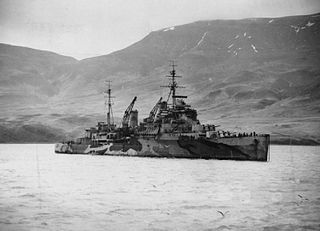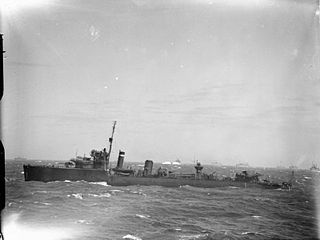
HMS Chaser (D32/R306/A727) was an American-built Attacker-class escort carrier that served with the Royal Navy during the Second World War.

PQ 13 was a British Arctic convoy that delivered war supplies from the Western Allies to the USSR during World War II. The convoy was subject to attack by German air, U-boat and surface forces and suffered the loss of five ships, plus one escort vessel. Fifteen ships arrived safely.

HMS Mahratta was an M-class destroyer of the Royal Navy which served during World War II. Begun as Marksman, she was damaged while under construction, and dismantled to be rebuilt on a new slipway. She was launched as Mahratta in 1942, completed in 1943, and quickly pressed into service. After a short but busy career in the North Atlantic and Arctic, largely guarding merchant convoys, she was torpedoed and sunk on 25 February 1944.

HMS Keppel was a Thornycroft type flotilla leader built for the Royal Navy at the end of the First World War. She was completed too late to serve in that conflict, but saw extensive service in the inter war years and in World War II. She was an effective convoy escort and U-boat killer, being credited with the destruction of five U-boats during the Battle of the Atlantic. She was the second of three ships named for 18th century Admiral Augustus Keppel.
Convoy PQ 11 was an Arctic convoy sent from Great Britain by the Western Allies to aid the Soviet Union during World War II. It sailed in February 1942 and arrived in Murmansk without loss.

Convoy JW 58 was an Arctic convoy sent from Great Britain by the Western Allies to aid the Soviet Union during World War II. It sailed in March 1944, reaching the Soviet northern ports in early April. All ships arrived safely. JW 58 was attacked by German U-boat and aircraft but suffered no losses. Three U-boats were destroyed and six aircraft were shot down during these operations.
Convoy JW 56A was an Arctic convoy sent from Great Britain by the Western Allies to aid the Soviet Union during World War II. It sailed in January 1944, reaching the Soviet northern ports at the end of the month. Twelve ships arrived safely. During the voyage JW 56A was attacked by a German U-boat force; three ships were sunk and one of the escorts damaged in the operation.

Convoy JW 56B was an Arctic convoy sent from Great Britain by the Western Allies to aid the Soviet Union during World War II. It sailed in late January 1944, reaching the Soviet northern ports at the beginning of February. All ships arrived safely. During the voyage JW 56B was attacked by a German U-boat force; no merchant ships were sunk, though one of the escorts was lost. One attacking U-boat was destroyed in the operation.
Convoy JW 55A was an Arctic convoy sent from Great Britain by the Western Allies to aid the Soviet Union during World War II. It sailed in December 1943, reaching the Soviet northern ports at the end of the month. All ships arrived safely.

Convoy JW 55B was an Arctic convoy sent from Great Britain by the Western Allies to aid the Soviet Union during World War II. It sailed in late December 1943, reaching the Soviet northern ports at the end of the month. All ships arrived safely.
Convoy RA 55A was an Arctic convoy during World War II. It was one of a series of convoys run to return Allied ships from Soviet northern ports to ports in Britain. It sailed in late December 1943, reaching British ports at the end of the month. All ships arrived safely.
Convoy RA 55B was an Arctic convoy during World War II. It was one of a series of convoys run to return Allied ships from Soviet northern ports to ports in Britain. It sailed at the end of December 1943, reaching British ports in early January 1944. All ships arrived safely.
Convoy JW 54A was an Arctic convoy sent from Great Britain by the Western Allies to aid the Soviet Union during World War II. It sailed in November 1943, reaching the Soviet northern ports at the end of the month. JW 54A was the first out-bound Arctic convoy of the 1943–44 winter season, following their suspension during the summer. All ships arrived safely.
Convoy JW 54B was an Arctic convoy sent from Great Britain by the Western Allies to aid the Soviet Union during World War II. It sailed in late November 1943, reaching the Soviet northern ports at the end of the month. All ships arrived safely.
Convoy JW 51A was an Arctic convoy sent from Great Britain by the Western Allies to aid the Soviet Union during World War II. It sailed in December 1942, reaching the Soviet northern ports at the end of the month.
Convoy JW 51B was an Arctic convoy sent from United Kingdom by the Western Allies to aid the Soviet Union during World War II. It sailed in late December 1942, reaching the Soviet northern ports in early January 1943.

HMS Wanderer (D74/I74) was an Admiralty modified W class destroyer built for the Royal Navy. She was the seventh RN ship to carry the name Wanderer. She was ordered in January 1918 to be built at the Fairfield Shipbuilding and Engineering Company, Govan in Glasgow, being launched in May 1919. She served through World War II where she was jointly credited with five kills on German U-boats, more than any other ship of her class. In December 1941 the community of Sutton Coldfield in Warwickshire officially adopted her. In 1943 she was one of twenty one V&W class destroyers to be converted as Long Range Escorts. She was decommissioned after the war and sold for scrap in 1946.

HMS Walker (D27) was a W-class destroyer of the British Royal Navy that saw service in the final months of World War I, in the Russian Civil War and in World War II.

HMS Whitehall, pennant number D94, later I94, was a Modified W-class destroyer of the British Royal Navy that saw service in the Second World War.

HMS Dianella was a Flower-class corvette of the Royal Navy. She served during the Second World War.











